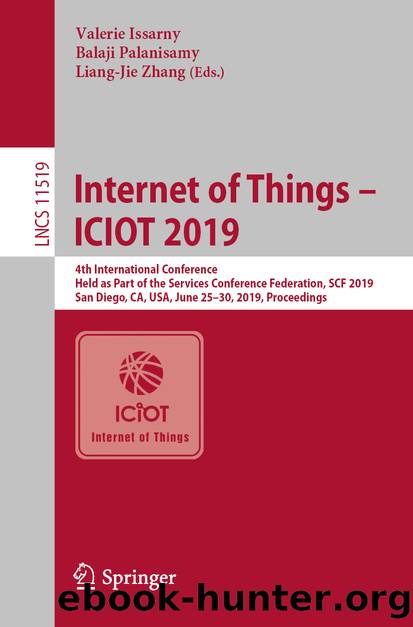Internet of Things â ICIOT 2019 by Unknown

Author:Unknown
Language: eng
Format: epub
ISBN: 9783030233570
Publisher: Springer International Publishing
Fig. 2.Ontology-based SLA management
4 SLA Contextual Ontology
The SLA specification defines the standard format of an agreement, which requires a non-ambiguous description of services. The key requirements of defining an SLA schema in the IoT environment are simplicity, reusability, readability and efficiency [18]. In other words, the SLA ontology should contain all the necessary information for automatic SLA management but in the meanwhile, remain as simple as possible. In IoT, three well-accepted concepts are the entity, resource and service [2]. The semantic models of these concepts are associated with each other by attributes such as location, domain information, physical concept and observations. Since an end user may focus more on the service-oriented aspects rather than the physical sensor information described by a sensor ontology, it is useful to merge the important attributes of the entity model and resource model to the service model, and provide a uniform SLA ontology for IoT services.
We built an SLA ontology, called WIoT-SLA, based on an extendable web service SLA specification WS-Agreement (WSAG) [1], which supports for SLA negotiation and widely used in cloud computing projects [15]. We formalized the structure of WIoT-SLA by extending WSAG with IoT domain-specific concepts to improve the readability and efficient traversability of SLA and SLAT. The steps to achieve this were: (i) We linked the domain knowledge relating to sensing, actuating and processing tasks to real-world resources, which enables more flexible and scalable solutions for different IoT application tasks (Sect. 4.1: Service Description Term). (ii) We proposed a high-level abstraction of sensing service configuration properties, enabling applications to avoid complex details about devices (e.g., Fig. 5). (iii) We defined the syntax of guarantees and QoS metrics to facilitate SLA monitoring (Sect. 4.1: Service Property). (iv) We extended the WSAG template schema to solve the template synchronization problem and reduce the message payload during SLA negotiation (Sect. 4.1: SLA Template Structure). (v) We formalized the structure of negotiation offers by extending the WS-Agreement Negotiation specification (WSAG-Negotiation) with offer validation rules and rejected reasons to avoid invalid interactions (Sect. 4.2).
Download
This site does not store any files on its server. We only index and link to content provided by other sites. Please contact the content providers to delete copyright contents if any and email us, we'll remove relevant links or contents immediately.
Influence: The Psychology of Persuasion by Robert B. Cialdini(4715)
The Miracle Morning by Hal Elrod(4637)
The Hacking of the American Mind by Robert H. Lustig(4318)
Pre-Suasion: A Revolutionary Way to Influence and Persuade by Robert Cialdini(4145)
Unlabel: Selling You Without Selling Out by Marc Ecko(3588)
Ogilvy on Advertising by David Ogilvy(3508)
Hidden Persuasion: 33 psychological influence techniques in advertising by Marc Andrews & Matthijs van Leeuwen & Rick van Baaren(3472)
Purple Cow by Seth Godin(3139)
Who Can You Trust? by Rachel Botsman(3087)
Kick Ass in College: Highest Rated "How to Study in College" Book | 77 Ninja Study Skills Tips and Career Strategies | Motivational for College Students: A Guerrilla Guide to College Success by Fox Gunnar(3075)
The Marketing Plan Handbook: Develop Big-Picture Marketing Plans for Pennies on the Dollar by Robert W. Bly(2975)
This Is Marketing by Seth Godin(2971)
I Live in the Future & Here's How It Works by Nick Bilton(2935)
The Power of Broke by Daymond John(2897)
Building a StoryBrand by Donald Miller(2841)
The Tipping Point by Malcolm Gladwell(2827)
The 46 Rules of Genius: An Innovator's Guide to Creativity (Voices That Matter) by Marty Neumeier(2796)
Draw to Win: A Crash Course on How to Lead, Sell, and Innovate With Your Visual Mind by Dan Roam(2734)
Market Wizards by Jack D. Schwager(2643)
